
Aspen groves, spruce-fir forests, and lodge pole pine stands harbor a range of herbaceous wildflowers throughout Jackson Hole. Some kinds grow in dense shade, others find intermittent patches of sun to thrive. Bloom time is short as plants need to flower and then begin to form fruits quickly before fall comes all too soon. So best for curious flower folk to get out soon and if the flowers are fading at lower elevations, hike higher. Indeed, It is hard to keep up with what is in bloom at this time of year.

The photos below help you to identify the plants at a glance and then in detail. The text will help you take a much closer look at the intriguing details of the flowers and life cycle. Also, there are a few extra “cool facts” to share with friends on your hikes. By having a “conversation” with the plant you can get to recognize it all the better on the next encounter. A 10x handlens, easy to buy by mail order, adds to the pleasure.
First the Whites Flowers:
Red baneberry – Actea rubra – has a raceme of small flowers at the end of a long stem. Look closely at the delicate white flower parts into the center where you can see the thick ovary with a stigma on top.

Attracted to the white array of flowers in the shade of the forest, several pollinators alight and clamber around thereby spreading pollen onto a stigma. Then the ovary will begin to expand into a bright red (or white) fruit. In the fall, the raceme bares shiny red, poisonous (to us) fruits. In olden times, “bane” indicated poison or misfortune. Fortunately, the fruits don’t taste good, so a child (or other curious person) is likely to spit the fruit out if tempted. Baneberries can be attractive landscape plants.

Woodland Strawberry – Fragaria vesca –– grows here as well as Europe and Asia where the fruits have been eaten since the Stone Age. We have two strawberry species in Teton County. To distinguish them, look closely: the three-parted leaves: the terminal toothof the leaflet is greater or equal to the side two teeth and the leaves are deeply veined. Later the seed-like fruits will sit atop the red flesh of the swollen stem.

Look out also for our Blue-leaf or Wild Strawberry – Fragaria virginiana – which is native only to North America. It is one of two parents to our commercial strawberry. The terminal tooth is shorter than the two adjacent teeth and the leaves are usually blue-green. The fruits will be different as well…more later.

Mitreworts – We have two species of Mitella which have particularly delicate looking flowers. I often see them along a trail edge or slope where these small plants don’t have too much competition. They have a cluster of scalloped leaves at the base, and then wands of greenish to white flowers on 8-12” stalks. You have to get down low to see the details of the flower. They are in the Saxifrage Family.

Five-stamen Miterwort – Mitella pentandra – has a saucer-like cup of fused green sepals; the petals (not stamens as in the common name implies) are greenish and divided into 5-or-more linear parts like snowflakes. At their base are tiny white anthers with a stigma poking up in the center. Nectar glands fill the saucer and help cover the ovary.

Side-flowered Miterwort – Mitella stauropetala – flowers are held more or less on one side of the stalk, as the name indicates. The sepals are more pronounced: white and triangular. The petals are thread-like, barely branched and the center more of a cup.

Our two False Solomon’s-seals can be a bit confusing. Both make attractive garden plants for the shade as their leaves are tidy and the rhizomes will slowly extend for the plants to fill in shady spots. White flowers are clustered at the end of the arching stems and later will bare colorful fruits. Here are the technical differences to help close observation and memory:
Starry False Solomon’s Seal – Maianthemum stellatum – has narrower, often bluer-green leaves. The white flowers are in a raceme—single flowers are at the end of short stalks that come off a central stalk as if they are each racing way from the center line.

False Solomon’s Seal – Maianthemum racemosum – has broader, larger, more arching, greener leaves.

The white flowers are more bunched and plentiful. Technically the inflorescence is a panicle. The flowers are at the end of a stalk that comes off a stalk from the center stalk, as if racing away in all directions as in panic.
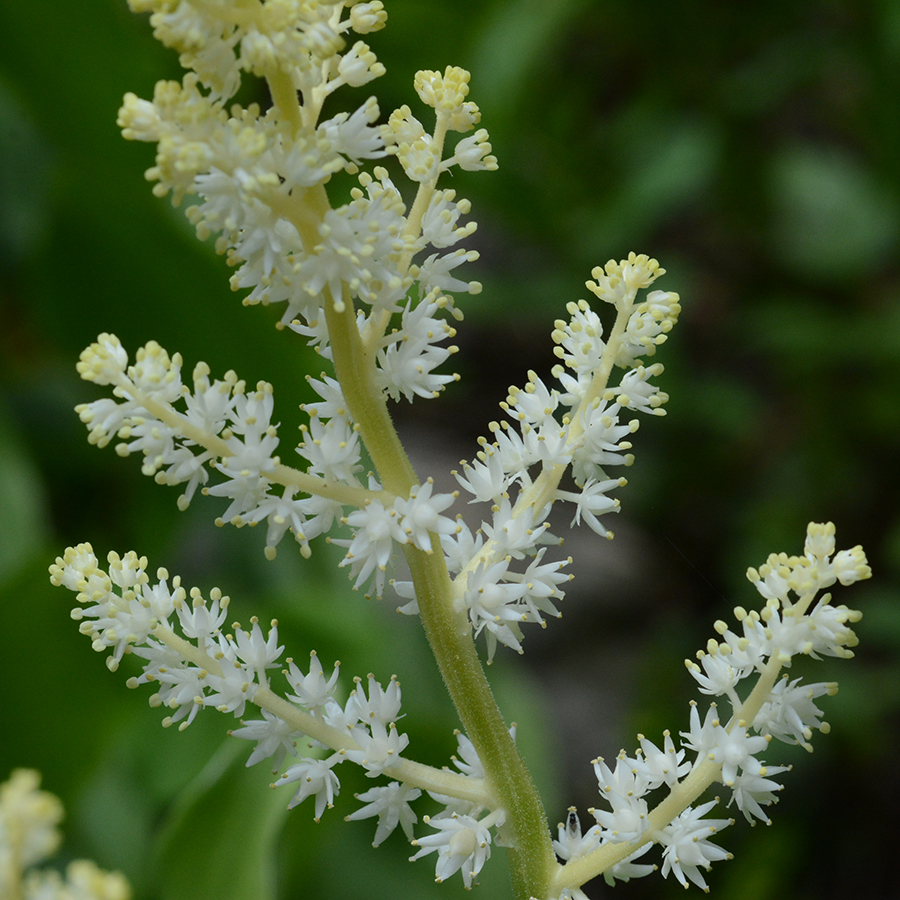
Western Valerian – Valeriana occidentalis – has been flowering along shady trail edges and in open meadows since early spring. It has a bunch of flowers (thryse) at the end, with at least one pair of opposite, compound leaves on the stem,

and more mostly simple (undivided) leaves at the base.
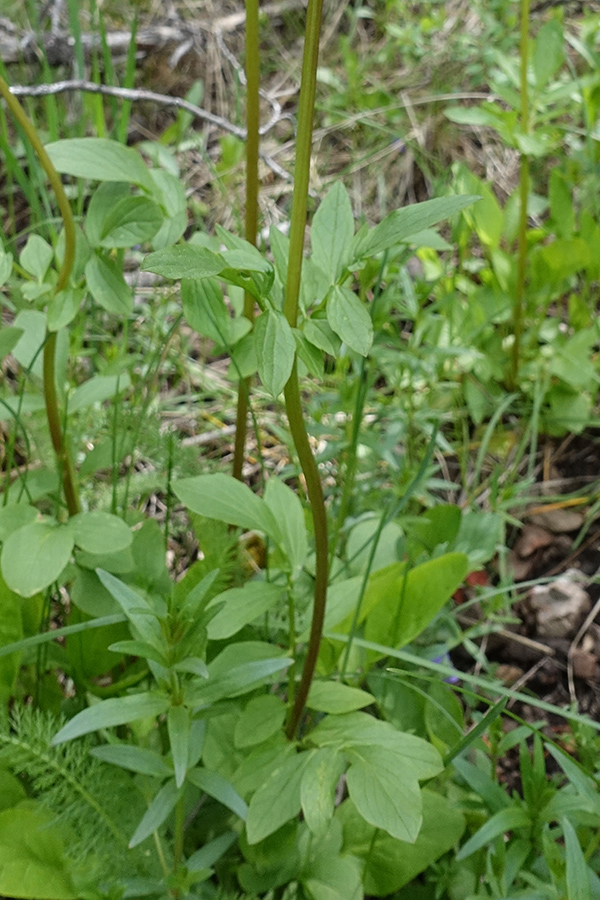
Many people know of valerian as a sleeping aide. Indeed, it is related to the European species V. officinalis which is a powerful nervine and sedative. Another local species Tobacco Root – V. edulis – will be blooming soon (more info in a later posting). Plant identification and research are very important in using any plant medicinally.
Cheerful Yellows:
Heart-leaved Arnica – Arnica cordifolia – is one of several arnicas here in Teton County. Arnicas have opposite leaves and usually bright-yellow flower heads with rows of even-sized bracts protecting the many flowers inside.


True to its name, this arnica has 1-2 pairs of heart-shaped leaves on short stalks, and a few others at the base. Arnica has been used successfully as a topical to help with bruising; however, ingestion can be toxic.
Bracted Louseworts– Pedicularis bracteosa – are just sending up their 1’ flower stalks from a whorl of fern-like compound leaves. The whole plant will reach 2-3’. Amazing how much biomass is produced in only a few weeks!

The flowers are bee pollinated: a bee lands on the lower lip of three fused petals. If it is the right bee species, it will vibrate its wings at a particular velocity, which causes the pollen hidden in the arching upper lip to fall upon the bee. The bee flies away, tries to glean the pollen off its back, but can’t reach the crevice between head and thorax. When the bee visits another flower in a later stage of growth, the flower stigma sticks out to reach between the crevice, thereby being smeared with pollen. Voilà, pollination!

Some Blues:
Silvery Lupines – Lupinus argenteus – are beginning to bloom in pine forests, often amongst the yellow arnicas.
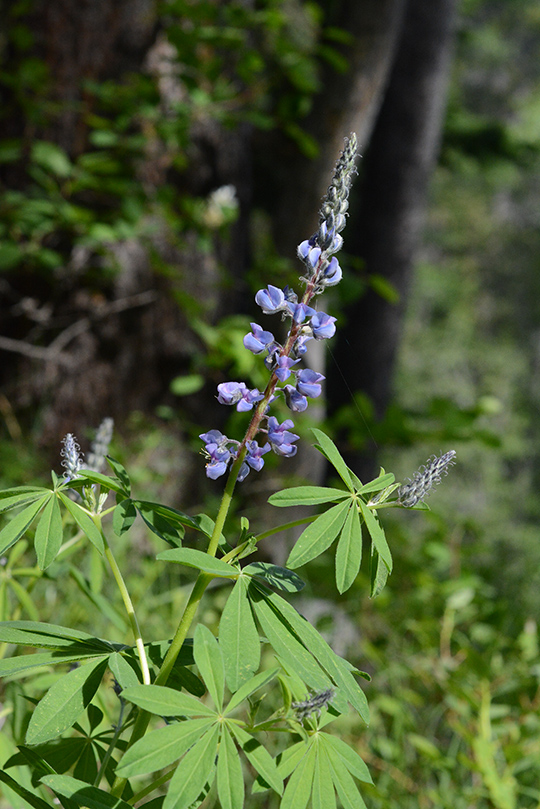
This shade-loving species has less hairy leaves and smaller, more closed flowers than the Silky Lupine – L. sericeus – of open sunny areas.
Vines of Western Clematis – Clematis occidentalis – have been wrapping themselves upon any woody stem in the forest and blooming profusely. The blue “petals” are actually sepals.

The sweet blue Dog Violets – Viola adunca – are occasionally seen along forest trails in sunny spots. We have other blue violets, but this species has a long spur in the back that holds nectar for pollinators which are strong enough to push in and reach this reward.

Wikepedia warns, “The leaves and flowers are edible and can be eaten in salads, as potherbs, or brewed as tea. These plant parts are high in vitamins A and C. However, the rhizomes, fruit, and seeds are poisonous to humans and can cause upset stomach, intestinal problems, respiratory and circulatory depression.” Maybe violets aren’t so “sweet”.
Green:
Sweet Cicely – Osmorhiza occidentalis – grows in moist shady places. It is easy to place it in the Carrot/Parsley or Apiaceae family, formerly the Umbelliferae. Very early on, the Greeks saw the similarities that now have become formal taxonomic identifiers for the family: the umbel arrangement of small flowers, e.g. the flower stalks coming from a central point like the ribs of an umbrella (umbel and umbrella have the same entymology) and typically compound leaves often with broad petioles.

Plants in this family–dill, anise, coriander, celery seed, and notably poison hemlock – Circuta maculata–also contain many fragrant to deadly chemicals. Pinch the leaves of Sweet Cicely: they smell like licorice or anise. Likely the Greeks, appreciated the foods and medicines the family provides.

The sturdy structure of umbels enable pollinators to land and crawl around the tiny flowers which have glistening nectar glands.
No Color Needed for Wind:
Wind pollinated flowers are in abundance now: grasses and sedges, as well as conifers. Below is a picture of a poof of pollen in the valley, likely spruce pollen. Wind-distributed pollen has to be very light to fly upon the air. No wonder allergies are rampant right now. Pollen distributed by insects is relatively heavy–one reason why strong insects are needed.

Western Meadow-rue – Thalictrum occidentalis – Is a delicate looking plant with divided leaves.

As it is wind pollinated, it does not have showy petals to attract pollinators. Instead, it depends on luck. Male plants produce small flowers with lots of dangling anthers that shed pollen upon the wind.

Hopefully, nearby is a female plant with flowers that hold up sticky stigmas to catch the pollen. Lots of bets are placed…lots of pollen is released to increase the chances of reaching a female.
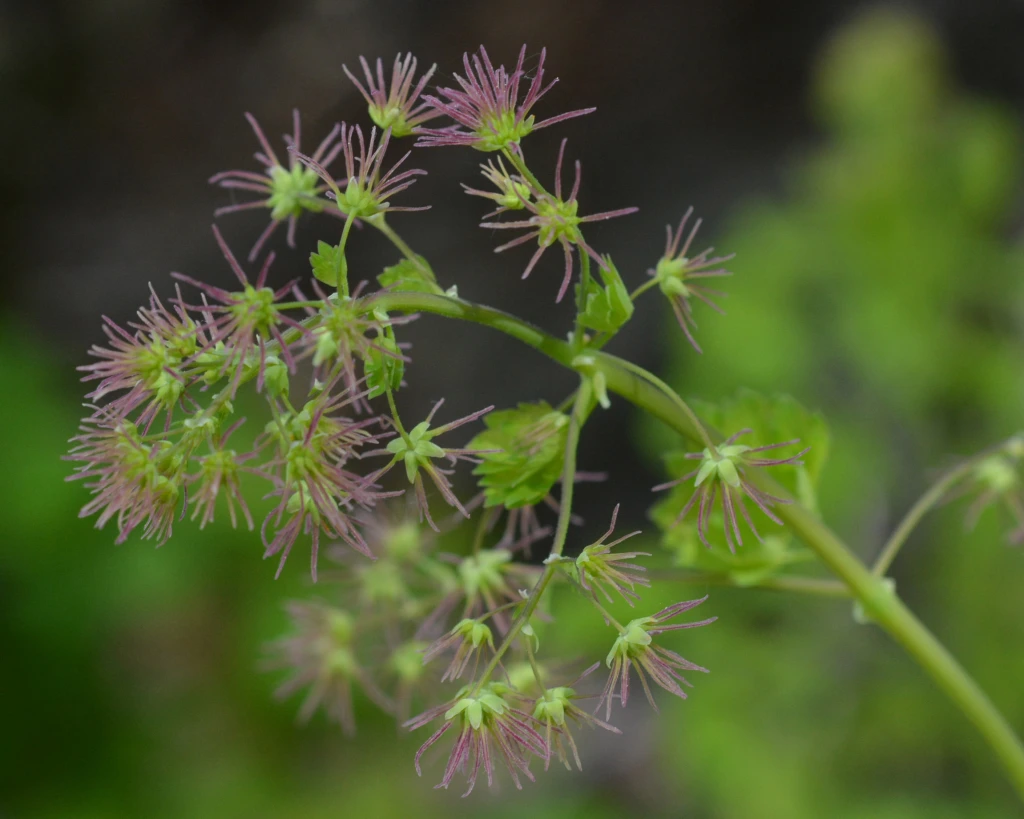
If the pollen does happen to reach the stigma, the pollen grains grow down to form seeds within the ovaries below. So far, I have seen many more male plants than female plants. Having separate male and female plants helps increase genetic exchange for long-term survival of the species.
Elk Sedge – Carex geyeri – Also pollinated by wind, this species has a slightly different strategy. On the same spike, several male flowers produce anthers above and 1-3 female flowers produce long stigmas below. Often the flowers come out at different times to avoid self-fertilization.

With sedges, the fruits form within a vase-like structure called a perigynea and each flower has a scale at its base. Elk Sedges have very deep roots that help to hold the soil in place on slopes, and the evergreen leaves are indeed eaten by elk.

Orchids:
Orchids have very tricky and involved life strategies—the family is one of the most diverse and evolutionarily advanced in the world. The flowers are intricately designed to attract and fit only specialized pollinators, which are often still unknown to researchers. Once they are pollinated, orchid plants produced very fine, dust-like seeds without extra food. (Think about the contrast with bean or pea seeds which have a little nub of an embryo and lots of starchy food around it). The tiny orchid seeds depend on mycorrhizal fungi being present in the soil to nourish the tiny embryo. In many cases, a “protocorm” slowly grows underground expanding with the aid of the fungus. Once a shoot reaches the sun to produce its own food, many orchids retain a relationship with the helpful fungi. And some orchids have no chlorophyll and completely depend on fungi for their survival. For these reasons, never pick an orchid; just admire.
Fairy Slipper – Calypso bulbosa – is truly a delight to find. It has a fancy array of sepals and petals and alternating fragrances to provide allure to young queen bumblebees.

The bee lands on the flower, and unknowingly to her, a wad of pollen called a pollinia may become attached to her before she flies to the next flower…searching again for a reward. The next flower may have a protruding female stigma poised to receive the male pollinia. If so, hundreds of seeds can begin to form. Meanwhile the queen bee receives no reward of nectar or pollen and eventually learns not to bother to look for them.
We have several species of coralroot in Teton County. The one I have seen currently in bloom is Spring Coralroot – Corallorhiza wisteriana.

This species is particularly notable because the clusters of stems can be reddish or yellow, and they may grow right next to each other.

Coralroot orchids have no chlorophyll and therefore depend on mycorrhizal fungi to provide carbon and other nutrients to keep them growing (myco-heterotrophic). The underground mycelial threads of the fungi attach to stubby root-like structures called haustoria, which look like coral, hence the common name.
An Ancient One:
Field Horsetail – Equisetum arvense – Horsetails are in an ancient “order” of plants that has persisted over 350 million years. Their ancestors grew 45’ tall and1.5’ in diameter and formed forests when the dinosaurs roamed. Those plants are now being mined for coal. This is a photo of the strobilus on top of a brown stem separate from the branching green horsetails we see.
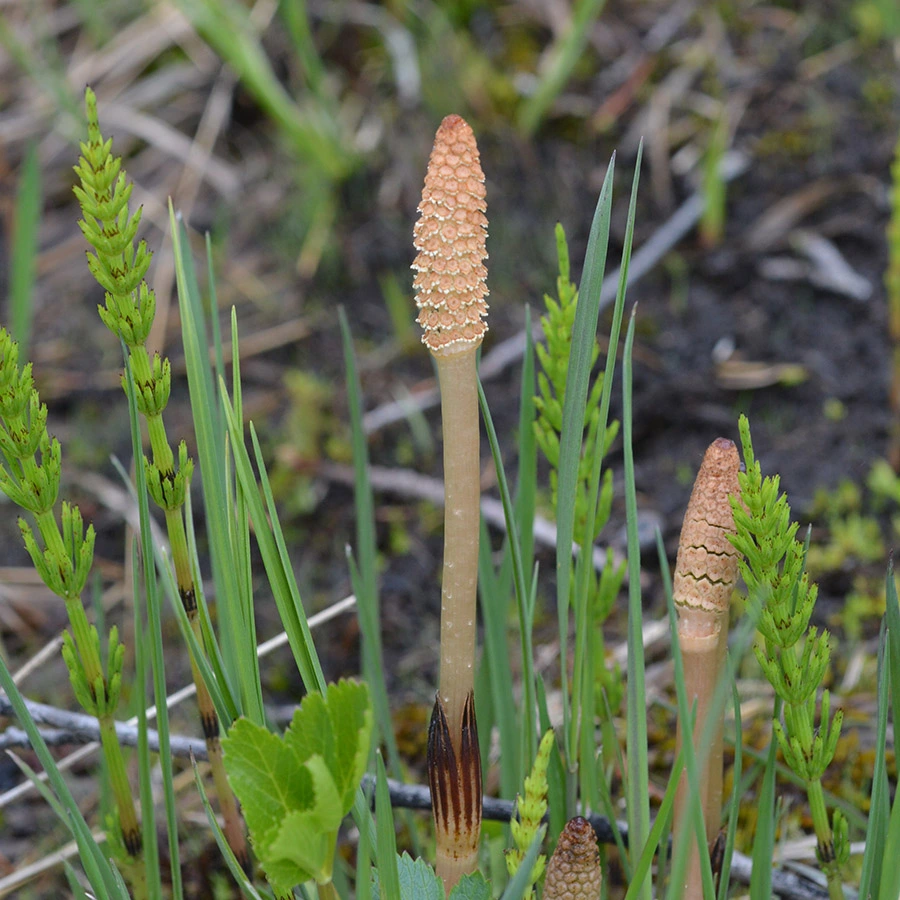
The cone it is releasing spores with elaters, appendages that will help the spores move on the wind. The spores will form an alternate generation of barely visible green sexual plants: gametophytes which produce either eggs or sperm. With rain, the sperm swims to eggs, and the plants we know as horsetails then sprout up. It takes these “alternating generations” to complete the very primitive, but clearly time-tested, life cycle of a horsetail. Ferns reproduce in essentially the same way.
Time to Get Out Botanizing
There are more flowers to bloom in forest openings and trailsides in the months to come. Trails up Cache and Trail Creeks, around String and Jenny Lakes, around Munger Mountain, and a bit later up to Ski Lake are readily accessible forest habitats. Myriad native insects depend on our native flora and they cannot survive on non-native species. Native insects provide critical proteins for baby birds. And the fruits will also nourish adult birds and mammals. If you have a garden, growing native plants is one way to steward our remarkable ecosystem. In any case, wildflowers are fun to observe and understand. Enjoy.
Frances Clark, Teton Plants, Wilson, WY
June 22, 2022
P.S. To hear about our programs and most recent postings directly, please contact tetonplants@gmail.com to be placed on our mailing list. Also, let us know of any errors. We want to be accurate.

Great posts! Really appreciate the photos and commentary. Here in the Bighorns, we have many similar plants.
>
Baneberry not “bainberry”✅🌺
Abigail Karin
Frances Just in Time! We were just wondering about the white flowering stems outside our window next to the creek. Red Bainberry. Thank you. I’ve just begun to walk. A mile up Cache Creek yesterday with Sid. How extraordinarily fortunate I am to get out while nature is blooming. Abi
Abigail Karin
I really appreciate these emails. So informative and great pictures. Thanks. Sandy Greenbaum
“Be the reason someone believes in the goodness of people.”
Karen Salmansohn –
>